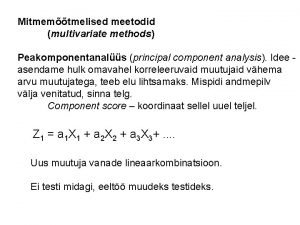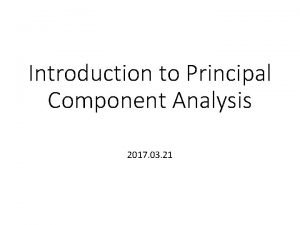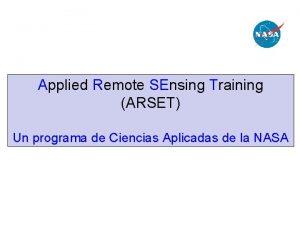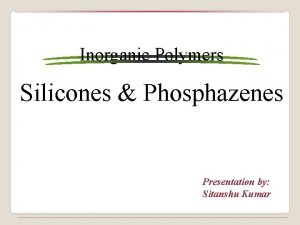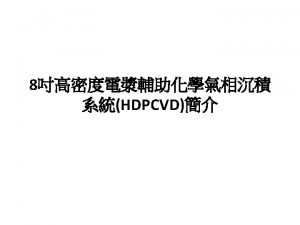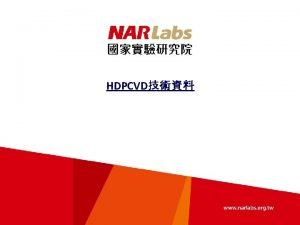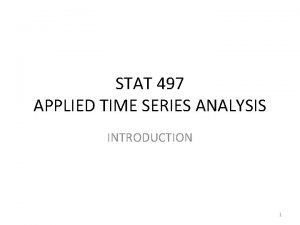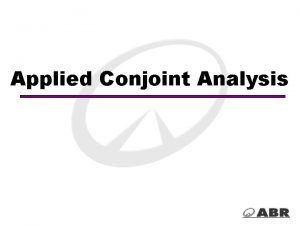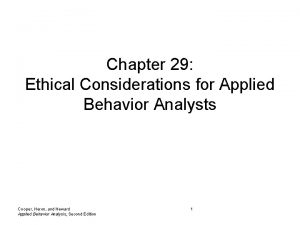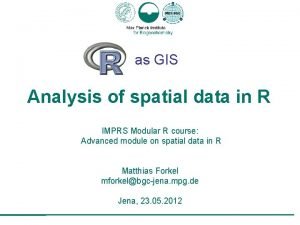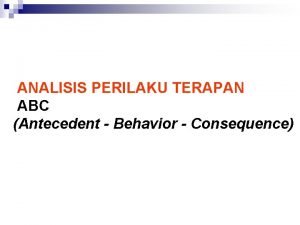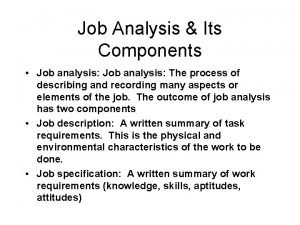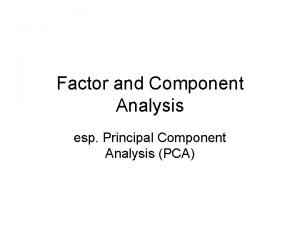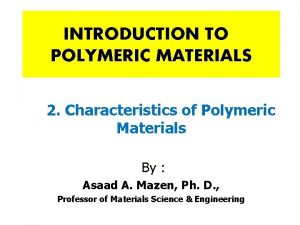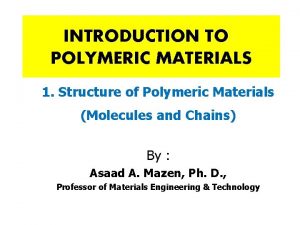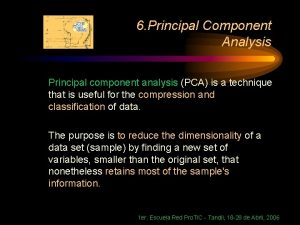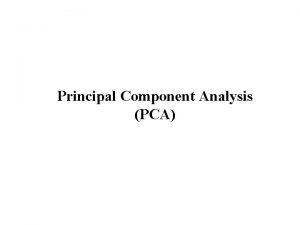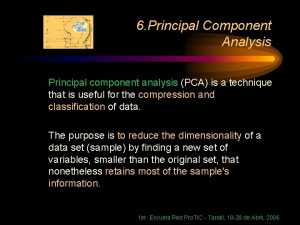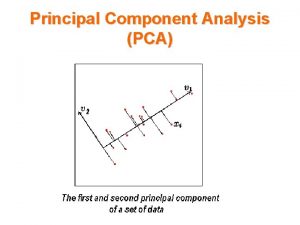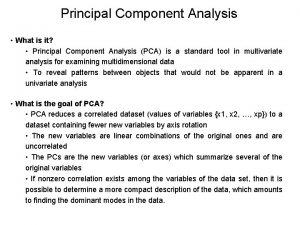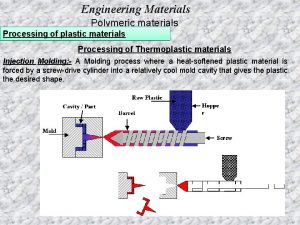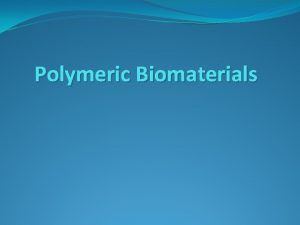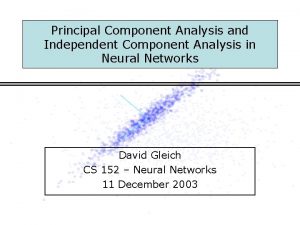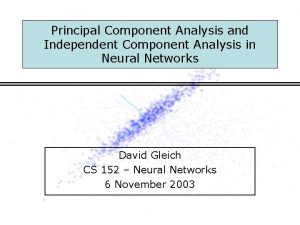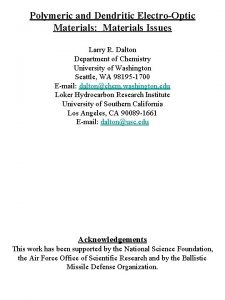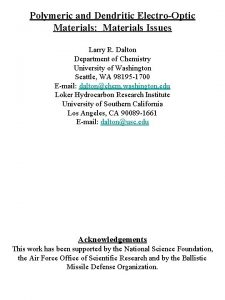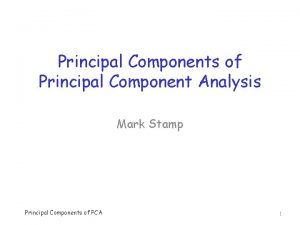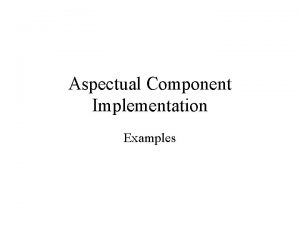Principal Component Analysis Applied to Polymeric Sensing Materials






























- Slides: 30

Principal Component Analysis Applied to Polymeric Sensing Materials Alison J. Scott and Alexander Penlidis Department of Chemical Engineering Institute for Polymer Research (IPR), University of Waterloo 40 th Annual Symposium on Polymer Science/Engineering Wednesday, May 9 th, 2018

Introduction �Why Gas Analyte Detection? Analyte Application Ethanol Acetone Benzene Reduce drinking & driving Diagnose diabetes Monitor indoor air quality �Why Polymeric Sensing Materials? Good sensitivity and selectivity Room temperature operation Product customization potential ▪ Backbone/functional group selection & polymer doping 2

Sensing Materials �Sensitivity: Related to sensor’s detection limit Lower detection limit = more sensitive sensor �Selectivity: Ratio between responses (target analyte vs. interferent analyte) Stewart, KME; Chen, WT; Mansour, RR; Penlidis, A. (2015) Journal of Applied Polymer Science 132 (28). 3

Experimental Test System Analyte MFC Analyte Passive Mixer PC FM Gas Chromatograph MFC Sample MFC: Mass Flow Controller, PC: Pressure Controller, FM: Flow Meter, GC: Gas Chromatograph Stewart, KME; Penlidis, A. (2013) Macromolecular Symposia 324 (1). 4

Principal Component Analysis (PCA) �Experimental work → large data sets PCA allows us to “see” useful trends �For sensing materials, PCA acts in essence as a filtering algorithm Filtering Algorithm (and clusters) PCA helps us to determine interrelationships among variables Collect responses from a variety of sensing materials Combine data to simulate a sensor array 5

Principal Component Analysis (PCA) �How does PCA work? Decomposes the data matrix (n observations & p variables) into: a) A score matrix (related to observations/cases) b) A loading matrix (related to variables) n Data p ≈ n Scores m x Loadings m p These show us the inter-relationships among the observations and among the variables 6

Case Study �Use PCA as a filtering algorithm for sensing materials Loadings: show separation between analytes (variables) to distinguish between different cases Scores: provide information about how observations are linked 7

Case Study: Po. ANI �Derivative of polyaniline, poly-o-anisidine (Po. ANI) Undoped Doped with Ni. O or Zn. O nanoparticles �Use individual materials (or combinations) to detect gas analytes Methanol, acetone & benzene 8

4 Individual Gases; 1 Material �Loadings: which combination of factors gives best separation? 9

4 Individual Gases; 1 Material �Scores: easy distinction between all 4 gases (reference plot for unknown gases) Benzene may be difficult to detect in gas mixtures… 10

4 Individual Gases; Material Array �Material Array: combination of 3 Po. ANI- based sensing materials to improve separation 11

4 -Gas Mixture; Material Array � 4 -Gas Mixture: can individual gases still be identified when we include gas mixture data? �Experimental data include material responses to: Individual gases: Methanol (M), Ethanol (E), Acetone (A) & Benzene (B) 2 -Gas Mixtures: ME, MA, MB, EA, EB, AB 3 -Gas Mixtures: MEA, MEB, MAB, EAB 4 -Gas Mixture: MEAB 12

4 -Gas Mixture; Material Array � 3 -Material Array: does a material array help with gas identification? 13

4 -Gas Mixture; Material Array � 2 -Material Array: 2 sensing materials give better separation than 3 (better without Po. ANI) 14

4 -Gas Mixture; Material Array � 2 -Material Array: methanol, ethanol and acetone can be identified individually Benzene & Benzene-containing Mixtures 15

4 -Gas Mixture; Material Array � 3 -Material Array: adding another (benzene- sensitive) material improves array performance 16

Do Results Make Sense? � Material array provides more sensing info and better separation (vs. individual sensing material response) No interaction between gases (parallel loadings) 17

Do Results Make Sense? � 4 -Gas Mixture: benzene interactions prevalent when gas mixtures are analyzed Benzene sorption > acetone sorption for Po. ANI w Zn. O Interactions? ▪ Benzene cannot be separated from other benzene-containing gas mixtures 18

Concluding Remarks �Principal component analysis (PCA) is a valuable tool for analyzing sensing data Filtering algorithm provides “separation” Statistical results agree with physico-chemical expectations �Information from PCA allows for tailor-made, improved sensor arrays 19

Principal Component Analysis Applied to Polymeric Sensing Materials Alison J. Scott and Alexander Penlidis Department of Chemical Engineering Institute for Polymer Research (IPR), University of Waterloo 40 th Annual Symposium on Polymer Science/Engineering Wednesday, May 9 th, 2018

References Stewart, KME; Penlidis, A. (2013) Macromolecular Symposia 324 (1). Stewart, KME; Chen, WT; Mansour, RR; Penlidis, A. (2015) Journal of Applied Polymer Science 132 (28). Stewart, KME; Penlidis, A. (2017) Polymers for Advanced Technologies 28 (3). 21

Sensing Materials vs. Sensors Sensing Material Response • Conductive • Δ Conductivity • Non-Conductive • Δ Capacitance • Lightweight • Δ Mass Sensor Type • Resistive Sensor • Capacitive Sensor • Mass-Based Sensor 22

Sensing Materials Bulk Polymer Properties • Depend on sensor type • Glass transition temperature • Physical structure • Affinity towards target analyte(s) Application-Specific Properties • Sensitivity • Selectivity • Other (e. g. stability) 23

Principal Component Analysis (PCA) �What is PCA? Multivariate data analysis technique Attempts to reduce total number of Filtering Algorithm variables by creating components or factors These factors account for the majority of the variation using fewer data points Method gives us a 2 -dimensional “window” through which we can look at a data set that contains many more variables 24

Principal Component Analysis (PCA) �How does PCA work? Creates factors, which are weighted linear combinations of the original variables ~86% variation in 3 PCs z 1 = a 11 x 1 + a 12 x 2 + … + a 1 p xp First few factors contain most of the variation (for the entire data set), so only a few “principal components” need to be retained for analysis 25

4 -Gas Mixture; 1 Material � 4 -Gas Mixture: separation of gases when mixture data is included in analysis 26

4 -Gas Mixture; 1 Material � 4 -Gas Mixture: is one sensing material enough to distinguish between gases? Acetone Methanol Ethanol Benzene & Benzene-containing Mixtures 27

4 -Gas Mixture; Material Array � 3 -Material Array: adding another (benzene- sensitive) material improves array performance Poly (2, 5 -dimethyl aniline) doped with Ni. O 16

Unknown Gas ID 29

Do Results Make Sense? �PCA: successful filtering algorithm for sensing material data Loadings show separation between analytes & predict degree of separation ▪ Outliers suggest which sensing materials may not be appropriate for detecting target analytes Scores show observations are linked ▪ Array performance is based on separation (and identification) of analytes ▪ Plots demonstrate how mixtures relate to pure (individual) gases & suggest interactions between gases 15
 Polymerization in dentistry
Polymerization in dentistry Principal component analysis spss
Principal component analysis spss Principal component analysis
Principal component analysis Jmp pca
Jmp pca Generalized principal component analysis
Generalized principal component analysis Principal component analysis
Principal component analysis Generalized principal component analysis
Generalized principal component analysis Applied remote sensing training program
Applied remote sensing training program Classification of inorganic polymers
Classification of inorganic polymers Gene interaction example
Gene interaction example Centura 5200 mainframe
Centura 5200 mainframe Amat centura dxz
Amat centura dxz Applied materials finishing
Applied materials finishing Natural materials and man made materials
Natural materials and man made materials Useful materials found at home
Useful materials found at home Man made materials
Man made materials What is adopting materials
What is adopting materials Direct materials budget with multiple materials
Direct materials budget with multiple materials Strong stationarity
Strong stationarity Cmot aba
Cmot aba Applied conjoint analysis
Applied conjoint analysis Ethical issues in applied behavior analysis
Ethical issues in applied behavior analysis Cooper heron heward
Cooper heron heward Business management courses winnipeg
Business management courses winnipeg Applied spatial data analysis with r
Applied spatial data analysis with r Teori perilaku abc
Teori perilaku abc International institute for applied system analysis
International institute for applied system analysis Discourse analysis in applied linguistics
Discourse analysis in applied linguistics Applied conjoint analysis
Applied conjoint analysis Components of job analysis
Components of job analysis Pca and ica
Pca and ica


